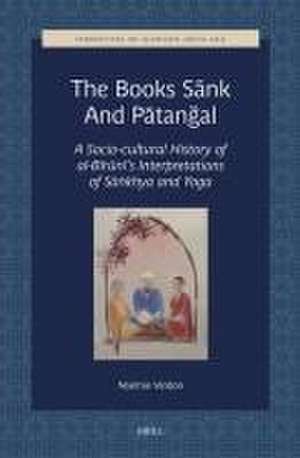The Books Sānk and Pātanğal: A Socio-cultural History of al-Bīrūnī’s Interpretations of Sāṅkhya and Yoga: Perspectives on Islamicate South Asia, cartea 2
Autor Noémie Verdonen Limba Engleză Hardback – 16 ian 2024
Al-Bīrūnī (ca. 973-1050) was an innovative encyclopaedist thinker. He is particularly known to have investigated into India of his time. Yet, his life and the circumstances of his encounter with Indian languages, culture and sciences are still shrouded in mystery and legends.
This research brings to light elements of his intellectual journey based on well-grounded analysis so as to contextualise al-Bīrūnī’s work of transmission of Indian philosophies into Arabic. Thanks to a theoretical framework rooted in a multidisciplinary approach, including Translation Studies, it enables to comprehend the full scope of his work and to analyse deeply his motives and choices of interpretation.
Preț: 497.06 lei
Preț vechi: 584.78 lei
-15% Nou
Puncte Express: 746
Preț estimativ în valută:
95.13€ • 98.94$ • 78.53£
95.13€ • 98.94$ • 78.53£
Carte indisponibilă temporar
Doresc să fiu notificat când acest titlu va fi disponibil:
Se trimite...
Preluare comenzi: 021 569.72.76
Specificații
ISBN-13: 9789004548534
ISBN-10: 900454853X
Pagini: 296
Dimensiuni: 155 x 235 mm
Greutate: 0 kg
Editura: Brill
Colecția Brill
Seria Perspectives on Islamicate South Asia
ISBN-10: 900454853X
Pagini: 296
Dimensiuni: 155 x 235 mm
Greutate: 0 kg
Editura: Brill
Colecția Brill
Seria Perspectives on Islamicate South Asia
Notă biografică
Noémie Verdon, PhD (2016), Maître assistante (SNFS), Department of South Asian Studies, University of Lausanne, has several academic publications on al-Bīrūnī and on the history of Indian thought. Her latest book Tantrisme, un chemin vers la liberté (L'Harmattan, 2023) is dedicated to a broad audience.
Cuprins
Acknowledgements
List of Figures and Tables
Abbreviations and Other Usages
Introduction
1 Cultural Contexts of al-Bīrūnī’s Work and Writings
1.1 Persian and Islamic Spheres of Influence
1.2 Al-Bīrūnī’s Visits to al-Hind
1.3 Elements of Culture of Gandhāra and Panjab
1.4 Concluding Remarks
2 The Social and Intellectual Contexts
2.1 Building up Theoretical Knowledge on al-Hind
2.2 Collaborations and Multiculturalism at Royal Courts
2.3 Al-Bīrūnī and Indian Scholars
2.4 The Transmission of Living Traditions
2.5 Concluding Remarks
3 Al-Bīrūnī’s Translations within the Sāṅkhya-Yoga Traditions
3.1 Sāṅkhya-Yoga Literature Predating al-Bīrūnī’s Time
3.2 Tenets of Sāṅkhya and Yoga
3.3 Authorships and Titles
3.4 Intersections and Disagreements of the Two Philosophical Systems
3.5 Concluding Remarks
4 Al-Bīrūnī’s Interpretative Strategies
4.1 Al-Bīrūnī’s Methods through the Lens of Translation Studies
4.2 Three Explicit Transformations
4.3 Al-Bīrūnī’s Reshaping of the Original Texts
4.4 Al-Bīrūnī’s Transformations of Content
4.5 Concluding Remarks
5 On the Kitāb Pātanğal and Its Sanskrit Source
5.1 Scholarship Review
5.2 The Commentary as an Integrated Part of the Kitāb Pātanğal
5.3 A Problematic Laudatory Passage
5.4 Concluding Remarks
6 On the Kitāb Sānk and Its Sanskrit Source
6.1 Scholarship Review
6.2 Methodological Considerations
6.3 Passages of the Kitāb Sānk and the Tradition of the Sāṅkhyakārikā
6.4 Concluding Remarks
Conclusion
Appendix: Passages Related to the Kitāb Sānk Found in the Taḥqīq mā li-l-Hind
Glossary of Sanskrit Terms as al-Bīrūnī Interpreted Them into Arabic
Bibliography
Index
List of Figures and Tables
Abbreviations and Other Usages
Introduction
1 Cultural Contexts of al-Bīrūnī’s Work and Writings
1.1 Persian and Islamic Spheres of Influence
1.2 Al-Bīrūnī’s Visits to al-Hind
1.3 Elements of Culture of Gandhāra and Panjab
1.4 Concluding Remarks
2 The Social and Intellectual Contexts
2.1 Building up Theoretical Knowledge on al-Hind
2.2 Collaborations and Multiculturalism at Royal Courts
2.3 Al-Bīrūnī and Indian Scholars
2.4 The Transmission of Living Traditions
2.5 Concluding Remarks
3 Al-Bīrūnī’s Translations within the Sāṅkhya-Yoga Traditions
3.1 Sāṅkhya-Yoga Literature Predating al-Bīrūnī’s Time
3.2 Tenets of Sāṅkhya and Yoga
3.3 Authorships and Titles
3.4 Intersections and Disagreements of the Two Philosophical Systems
3.5 Concluding Remarks
4 Al-Bīrūnī’s Interpretative Strategies
4.1 Al-Bīrūnī’s Methods through the Lens of Translation Studies
4.2 Three Explicit Transformations
4.3 Al-Bīrūnī’s Reshaping of the Original Texts
4.4 Al-Bīrūnī’s Transformations of Content
4.5 Concluding Remarks
5 On the Kitāb Pātanğal and Its Sanskrit Source
5.1 Scholarship Review
5.2 The Commentary as an Integrated Part of the Kitāb Pātanğal
5.3 A Problematic Laudatory Passage
5.4 Concluding Remarks
6 On the Kitāb Sānk and Its Sanskrit Source
6.1 Scholarship Review
6.2 Methodological Considerations
6.3 Passages of the Kitāb Sānk and the Tradition of the Sāṅkhyakārikā
6.4 Concluding Remarks
Conclusion
Appendix: Passages Related to the Kitāb Sānk Found in the Taḥqīq mā li-l-Hind
Glossary of Sanskrit Terms as al-Bīrūnī Interpreted Them into Arabic
Bibliography
Index

